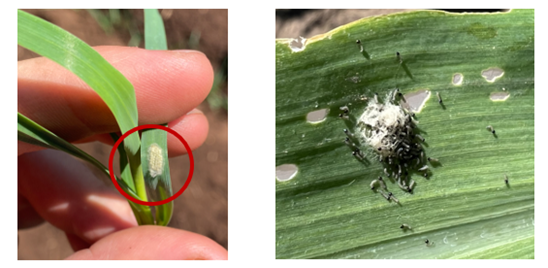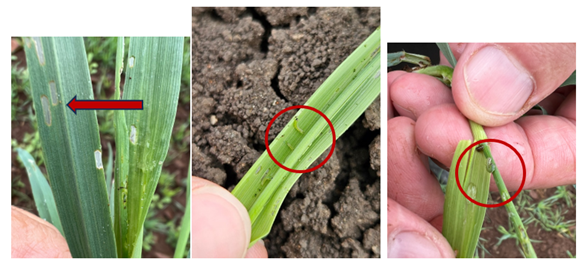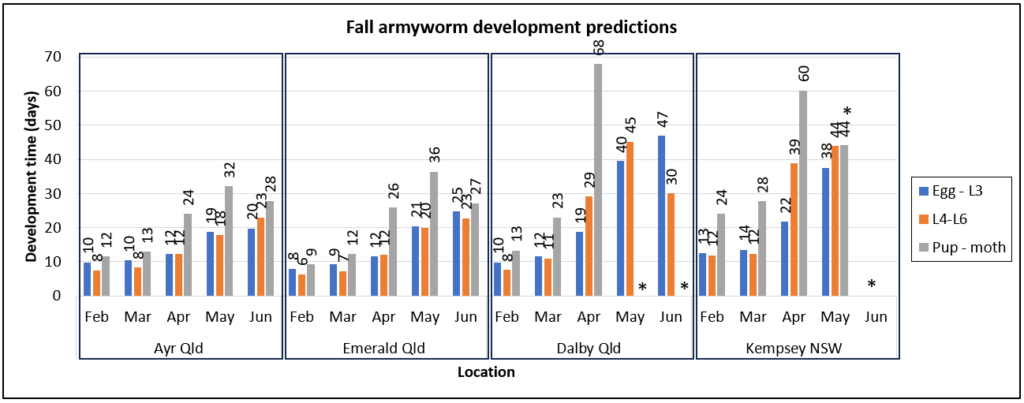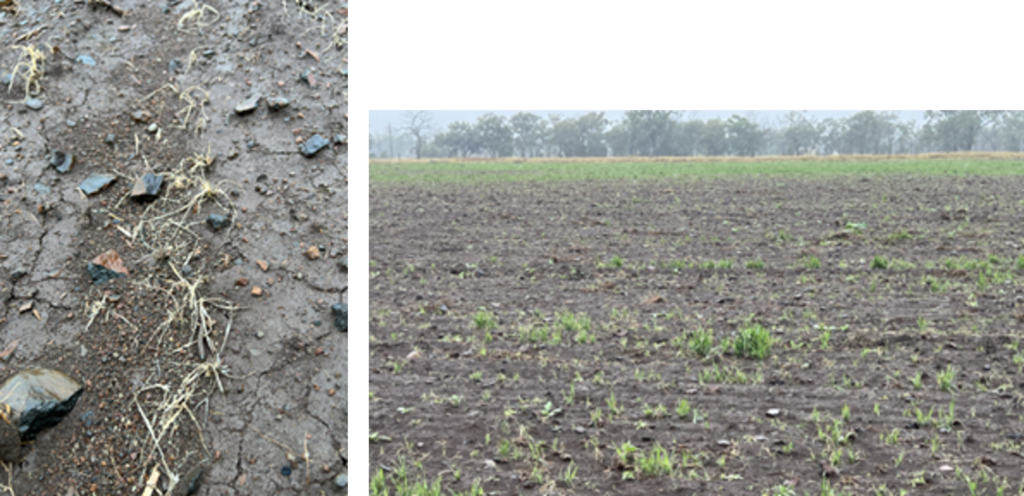Detecting and assessing fall armyworm infestations in winter cereals and pasture
Key messages
- All winter cereals and some grass pasture species are at risk of fall armyworm (FAW) infestation and potential crop loss.
- Crops are highly susceptible to severe defoliation and plant death from FAW feeding from emergence to tillering. Inspecting crops for damage and presence of larvae within a week of emergence is critical.
Oats and other winter forages are not usually checked for insect pests, but agronomists and growers are strongly encouraged to check crops for FAW this autumn. From late February and into March and April, we have seen infestations of FAW completely destroy oat crops across southern Queensland and into Northern NSW. Fewer cases have been reported from Central Queensland, but there are likely many producers who have not realised that their crop losses have been caused by FAW.
This article covers:
- Crops at risk
- What to look for when checking crops for FAW
- Management of FAW in winter cereals and pasture
- Important things to consider in the absence of effective insecticide options
- Temperature and FAW activity.
Crops at risk
- Winter cereals – oats, barley, wheat
- Pasture grasses – ryegrass, establishing Rhodes grass
Whilst we have not yet received reports of ryegrass being severely impacted, sowing mixtures of oats and ryegrass, for example, increases the risk of FAW damage to ryegrass. In these instances, FAW are likely to lay eggs directly on the oats and the larvae develop on the oats. When the oat plants are decimated, the risk is that large larvae will move onto the remaining ryegrass. Ryegrass is widely reported as being damaged by FAW in the United States (US).
What to look for when checking crops for FAW – type of damage and larvae
We suggest checking all at-risk crops within a week of emergence. FAW can develop and become active quickly under the right conditions (see Temperature and FAW activity below).
In many instances, growers only start to look closely at crops when they see bare patches or the crop doesn’t look to be growing as well as expected. Looking just at damage increases the risk that significant crop loss will have occurred before the infestation is detected. It is essential to check crops for the presence of larvae (caterpillars). Check for larvae by pulling up plants and unrolling the leaves to expose them.
For information on identifying FAW and distinguishing it from other caterpillar species visit the The Beatsheet’s FAW identification webpage.
Eggs are laid on leaves but are difficult to find. There may be over a hundred eggs in an egg mass, and the small larvae disperse when they hatch, infesting nearby plants.
Small larvae are concealed in the whorl of the plant. It is critical to pull plants apart to check for larvae. Simply looking for damage is not sufficient to determine the extent of the infestation and the ongoing risk to the crop.

Although small FAW larvae are actively feeding, they cause only minor damage to plants. Feeding by larval instars 1–3 (up to 10 mm long) results in ‘windows’ in leaves. Windowing is often the first sign of a FAW infestation and can be easily missed, especially if you are not in the paddock looking closely at plants and checking for larvae.

Large larvae do the vast majority of crop damage, and once there are 4th, 5th and 6th instar larvae in the crops the rate of crop damage increases dramatically. This is generally the point at which infestations are detected if no earlier crop checking has been done. This acceleration in crop damage gives rise to the perception that crops “disappear in a couple of days”. In fact, the infestations will have been there for a week or more as the larvae developed from small to large (see Temperature and FAW activity below).
Large larvae may not remain on plants during the day unless it is overcast. These bigger larvae hide in the soil at the base of plants during the day and likely emerge at night to feed. Whilst in the soil, they will feed on the stem of the plant. Scratch around the base of plants to check for larvae if you can see damage, but no larvae on plants.
Emerging winter cereals appear extremely susceptible to dying from stem damage caused by FAW.
Large larvae will defoliate plants and may lop mainstems or tillers.

Left: Oats seedlings killed by FAW feeding on mainstem. Right: Severe reduction in plant stand and biomass in an active FAW infestation in oats.
Management of FAW in winter cereals and pasture
No research has been undertaken on FAW management in winter cereals at this point.
As of 29 April 2024 there were no permits in place to allow for the legal use of insecticide to control FAW in any cereal or pasture crops, other than wheat (PER93481, emamectin benzoate). This situation creates major issues for producers who have a damaging FAW infestation. Permit applications are the responsibility of industry bodies.
There are permits in place for two biologicals; Fawligen® (PER90820) and Spodovir® Plus (PER91477) which cover use in cereal grains, fodder and forage, oilseeds, pulses, cotton, sweet corn and other vegetables. These are both FAW nucleopolyhedrosis viruses or NPVs.
NPV trials in vegetative sweetcorn, sorghum and maize, particularly under high FAW pressure, did not provided adequate control to prevent significant crop loss. To be effective, these products must be applied to very small larvae as they will not kill larger larvae. Cool temperatures will increase the time to death of larvae infected with NPV.
In the absence of effective insecticide options, it is important to consider:
- Once forage crops are established (tillering) they will be tolerant of some above ground defoliation, given they are bred for their ability to regrow after grazing via compensatory growth and tillering.
- Australian FAW populations are resistant to a number of chemical groups that are effective against other caterpillar pests like cutworm and native armyworm. These products will not adequately control damaging infestations, particularly if larvae are large. FAW is highly resistant to synthetic pyrethroids (e.g. alphacypermethrin) and moderately resistant to carbamates and organophosphates (e.g. methomyl, chlorpyrifos). Using these products is likely to result in poor control and continued crop loss.
- As average temperatures decline in most growing regions, the rate at which FAW develop and feed will slow down. Slower development means larvae are exposed for longer to a range of factors that can kill them e.g. rain, wind, predators, parasitoids, disease. The risk of crop loss decreases if larvae are not successfully progressing from small to large, and the overall number per plant is also declining.
- If feasible, delaying the planting of susceptible crops will reduce the risk of high-density infestations of FAW.
- If crop loss has occurred and resowing planned, be aware that FAW larvae may still be in the soil and may damage the resown crop as it emerges. Check the soil and any remaining plants before resowing.
- Where crops are severely defoliated by FAW, neighbouring crops are at risk of infestation as large larvae crawl out of the damaged crop looking for other sources of food.
Temperature and FAW activity
Importantly, FAW activity and rate of development will slow in most regions as temperatures cool. The graph below shows the predicted rate of development of FAW for four locations from north Queensland to the mid North Coast of NSW. The predictions are generated using the insect development model, DARABUG.

These data show that FAW can develop year-round in more northerly regions if suitable hosts are present. In more southerly regions, it is more likely that FAW populations will ‘die’ out or at least be reduced to very low levels over winter. The temperature threshold for successful FAW development is around 10°C.
US data shows that FAW larvae on plants can survive several hours of sub-zero temperatures (like occurs with a frost), but that moths are considerably less fit (poor emergence from pupae, low egg production) when they develop and emerge in cool temperatures.
For more information please contact Trevor Volp (0429 641 912) or Melina Miles (0407 113 306), Field Crops Entomology Team, Department of Agriculture and Fisheries (Queensland), Toowoomba.
